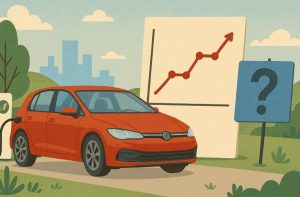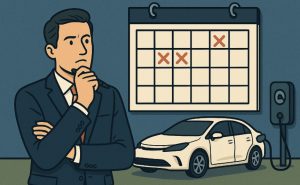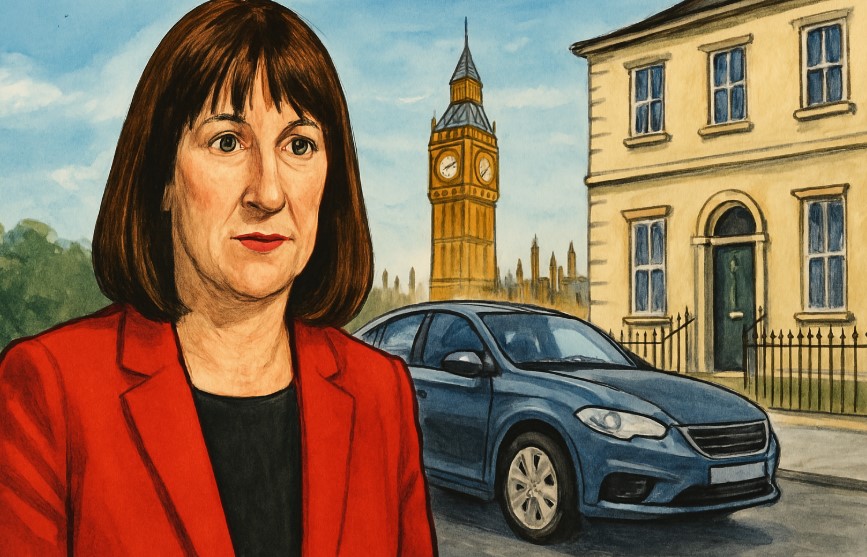Last Updated on: 16th April 2025, 09:08 am
Are you wondering how the recent Benefit-in-Kind (BIK) tax changes introduced by Rachel Reeves might affect your company car or vehicle fleet?
With new rules set to take effect from April 2025, drivers and employers across the UK are facing big shifts in tax rates for electric, hybrid, petrol, diesel, and even double cab pick-up vehicles.
Whether you’re considering an EV switch, managing a business fleet, or navigating salary sacrifice schemes, understanding these changes is essential.
This guide explores the upcoming reforms, why they’re happening, and how to prepare for them. From rising rates to reclassifications, we break it down to help you stay informed and financially prepared. Read on to find out what these changes really mean for your vehicle benefits.
If you’re a business owner or startup founder navigating the implications of these tax reforms, UK Startup Mag offers expert insights on finance, tax planning, and fleet management to help you stay compliant and cost-efficient in 2025 and beyond.
What Is Benefit-in-Kind (BIK) Tax?

Benefit-in-Kind (BIK) tax is a government charge applied to non-cash perks received from employers. For company car users, this means you are taxed on the benefit of using a vehicle provided by your employer for personal use.
Understanding how this tax works is essential for both employees and employers who provide vehicles under fleet schemes.
The BIK value is determined using several factors. These include the car’s P11D value, the list price including VAT and optional extras.
The CO2 emissions figure plays a major role, as higher polluting vehicles attract a higher tax rate. The fuel type is also considered, with electric vehicles currently attracting the lowest rates.
Finally, your income tax band determines the percentage of BIK you pay. The overall tax owed is calculated by multiplying the car’s BIK value by your personal income tax rate.
What Are the BIK Tax Reforms Introduced by Rachel Reeves?
Chancellor Rachel Reeves has introduced major BIK tax reforms that will reshape company car taxation from April 2025. Aimed at promoting cleaner vehicles and aligning with net zero goals, the changes affect electric, hybrid, petrol, diesel cars, and double cab pick-ups.
EVs will remain the most tax-efficient but will see gradual BIK increases. Hybrid vehicles will lose many of their tax advantages from 2028, while high-emission petrol and diesel cars will face rising rates. Double cab pick-ups will also be reclassified and taxed as cars, significantly increasing costs for sectors like construction and agriculture.
What Are the Latest BIK Changes Starting April 2025?
From April 2025, EVs will no longer have a flat 2% rate. BIK charges will rise yearly until 2029/30. Hybrids will face steeper increases from 2028. Petrol and diesel vehicles will reach up to 39% BIK, and double cab pick-ups will be taxed based on emissions.
How Will These Changes Affect 760,000+ Company Car Drivers?
Employees using company cars will face higher tax bills depending on the vehicle type. EV drivers will still enjoy the lowest rates, but hybrids and diesel users may see large increases. Businesses will also pay more in National Insurance due to higher BIK values.
These BIK reforms represent a strategic shift toward cleaner transport, and understanding them now will help both drivers and employers make informed, cost-effective decisions for the future.
What’s the BIK Roadmap for Electric Vehicles Until 2029/30?
The government has set out a structured BIK roadmap for electric vehicles (EVs) that will span from the 2025/26 tax year through to 2029/30.
This roadmap introduces a gradual increase in BIK rates for EVs, allowing both businesses and individual drivers to plan their long-term vehicle usage accordingly.
Although rates will rise, EVs will continue to enjoy the lowest tax bands available under BIK regulations. These reforms aim to strike a balance between maintaining incentives for zero-emission vehicles and closing the tax gap between EVs and traditional combustion engine vehicles.
This clarity is particularly beneficial for fleet operators and employees using salary sacrifice schemes, who depend on predictable costs over multi-year terms.
What Are the Exact BIK Percentages for Evs Between 2025 and 2030?
The government has confirmed a steady increase in BIK rates for electric vehicles:
| Tax Year | EV BIK Rate (%) |
| 2025/26 | 3 |
| 2026/27 | 4 |
| 2027/28 | 5 |
| 2028/29 | 7 |
| 2029/30 | 9 |
These rates offer transparency and a continued tax advantage for zero-emission vehicles compared to petrol and diesel alternatives, which typically start at 25% or more.
Why Are EVs Still Incentivised Despite Tax Increases?
Despite the incremental rise in BIK rates, EVs remain significantly more tax-efficient. The relatively low percentages ensure EVs are financially attractive for employers and employees alike.
The government continues to support EV adoption to meet national climate targets and reduce vehicle emissions.
Additionally, EVs result in lower operating costs, including fuel, maintenance, and congestion charges. The modest BIK rate increases allow the Treasury to recover some tax revenue without disincentivising the switch to electric vehicles.
How Do These Changes Affect EV Salary Sacrifice Schemes?
Salary sacrifice schemes remain one of the most cost-effective methods for employees to drive electric vehicles. Since BIK rates directly influence the taxable value of the benefit, the still-low EV rates ensure savings on National Insurance and income tax.
Even as the rates rise gradually, employees will benefit from substantial savings over petrol or diesel alternatives. Employers can also reduce Class 1A National Insurance contributions.
The long-term visibility provided by the roadmap helps HR and finance teams budget for benefit schemes over future tax years.
With a clear roadmap in place, EV users and businesses can plan ahead with confidence, taking advantage of lower BIK rates before they gradually rise over the coming years.
How Will Hybrid Vehicle BIK Rates Change in the Coming Years?

While hybrid vehicles previously offered a tax-friendly middle ground, the government is phasing out their incentives. Plug-in hybrids with emissions between 1–50g/km have enjoyed BIK rates linked to electric-only mileage, often making them a popular choice for fleet users.
However, under the new roadmap, that advantage will shrink. From 2028/29 onwards, all hybrids in this emissions category will be assigned a flat BIK rate regardless of how far they can travel on electric power alone. This change signifies a policy shift in favour of fully electric vehicles over part-electric options.
What Are the Current Rates for Hybrids (1–50g/km)?
Currently, BIK rates for plug-in hybrids range from 5% to 17%, depending on the vehicle’s electric range. Vehicles capable of driving further on electric power benefit from the lowest rates. For example:
- Over 130 miles: 5%
- 70–129 miles: 8%
- 40–69 miles: 12%
- 30–39 miles: 14%
- Under 30 miles: 16%
- Zero electric range: 17%
These rates were designed to reward energy efficiency and promote vehicles with stronger electric-only performance.
What Are the 2028/29 and 2029/30 Increases?
Starting from the 2028/29 tax year, hybrids with CO2 emissions between 1–50g/km will see their BIK rate set at 18%, rising to 19% in 2029/30, regardless of electric range.
This uniform approach simplifies the system but removes previous rewards for longer-range hybrids. The change significantly narrows the tax gap between plug-in hybrids and standard combustion engine vehicles, reducing their appeal as a long-term tax-saving option.
Why is the Government Reducing Incentives for Hybrids?
The new policy reflects the government’s goal of directing tax incentives toward fully electric vehicles. As the infrastructure for EVs improves and the cost gap narrows, hybrids are no longer viewed as a transitional technology needing support.
The flat-rate system for hybrids ensures a simpler and more transparent tax structure while reinforcing the long-term push for zero-emission transport. Businesses and drivers relying on hybrid tax advantages should begin to consider alternative options before 2028.
What Do the Changes Mean for Petrol and Diesel Car Owners?
Petrol and diesel cars are the most heavily impacted by the upcoming BIK tax changes. These traditional combustion engine vehicles already attract higher tax rates due to their emissions levels, and these rates will continue to increase annually.
The highest BIK band will rise from 37% to 39% by 2029/30. Diesel vehicles that do not meet RDE2 emissions standards will face an additional 4% surcharge, pushing some vehicles close to the upper tax threshold. These changes will likely lead to a significant reduction in demand for high-emission vehicles across company fleets.
How High Will Bik Rates Go for High-emission Vehicles?
From April 2025, BIK rates for vehicles emitting 160g/km of CO2 or more will increase annually. By 2029/30, the maximum BIK rate will reach 39%.
This applies to vehicles with the highest emissions and includes many luxury or performance models. The increase reflects the government’s intention to hold polluting vehicles more accountable.
| Tax Year | Max BIK Rate (%) |
| 2025/26 | 37 |
| 2028/29 | 38 |
| 2029/30 | 39 |
Which Diesel Models Will Be Hardest Hit?
Diesel cars that fail to meet the RDE2 emissions standard will face a 4% surcharge added to their standard BIK rate. High-powered diesel models and older diesel engines typically fall into this category.
Double cab diesel pick-ups will also be affected due to their reclassification as cars under BIK rules. These vehicles could face annual BIK charges of up to £15,000 for high-income earners, making them significantly more expensive to operate.
Are There Any Surcharge Exemptions?
Yes, diesel vehicles that meet the Real Driving Emissions Step 2 (RDE2) standard are exempt from the additional 4% BIK surcharge. This exemption encourages the use of cleaner diesel technology.
Additionally, vehicles that were ordered, leased, or purchased before April 2025 and meet the criteria for transitional relief may temporarily avoid the reclassification impact.
However, this relief only applies until the vehicle is disposed of or the lease ends, with a final cut-off date of April 5, 2029.
How Are Double Cab Pick-Ups Affected by the New BIK Rules?

The new BIK tax reforms bring a major change for businesses and individuals who rely on double cab pick-up trucks. Previously taxed as light commercial vehicles, these pick-ups will now be reclassified as cars for benefit-in-kind purposes from April 2025.
This means the flat-rate BIK structure that once offered tax simplicity and savings will be replaced with emissions-based taxation.
The change will significantly impact cost calculations for fleets in construction, agriculture, and trade sectors. High-emission diesel pick-ups could face steep increases, turning once cost-effective vehicles into major tax liabilities.
Why Are Double Cab Pick-ups Being Reclassified as Cars?
Under revised HMRC guidance, double cab pick-ups will no longer follow the VAT definition used for commercial vehicles. Instead, if their construction prioritises carrying passengers rather than goods, they will be taxed as cars.
This new interpretation aligns with a two-part test assessing the vehicle’s suitability for private use. As a result, pick-ups will be subject to BIK rates based on CO2 emissions and P11D value, not the flat commercial vehicle rate.
What Are the New BIK Costs for These Vehicles?
The switch to emissions-based BIK could increase annual costs by several thousand pounds. Under the old rules, pick-up drivers paid a flat BIK charge of around £3,960. Under the new rules, some users could face up to £15,000 per year, depending on their income tax band and vehicle emissions.
| Scenario | Estimated BIK Tax (Annually) |
| Current (Flat Rate) | £3,960 |
| Post-2025 High-Emission Pick-Up | Up to £15,000 |
This creates a strong incentive for tradespeople to reconsider their vehicle choices.
Which Industries Are Most Affected by This Change?
Sectors such as construction, farming, landscaping, and utility services frequently use double cab pick-ups due to their balance of passenger and cargo space.
The reclassification disrupts this cost-effective model. Fleet operators in these industries may now face higher taxes and National Insurance contributions.
Many businesses are expected to either switch to electric alternatives or revert to traditional vans, which still benefit from lower BIK rates under the current structure.
Is There Transitional Relief for Existing Double Cab Pick-Ups?
To reduce the financial burden on current owners and lessees, HMRC has introduced a transitional relief policy for double cab pick-ups.
This applies to vehicles that were ordered, purchased, or leased before April 2025. While the BIK reclassification still takes effect, these vehicles will be allowed to retain their current tax treatment for a limited period. This gives businesses and drivers a few extra years to adjust their fleets without immediate penalties.
What Happens if You Ordered Your Pickup Before April 2025?
If a business or employee acquired a double cab pick-up before 6 April 2025, they can continue using the flat-rate light commercial vehicle BIK scheme. This treatment will remain valid until the earlier of two conditions:
- The vehicle is sold or returned
- The lease or agreement expires
This gives some financial predictability in the short term while allowing time to plan for future changes.
How Long Will the Previous Tax Treatment Apply?
The transitional relief will remain available until 5 April 2029, or until the specific vehicle is no longer in use under the existing terms. After this deadline, all such vehicles—regardless of original purchase date—must comply with the new emissions-based classification and BIK rates.
| Cut-Off Dates | Transitional Treatment Applies? |
| Before 6 April 2025 | Yes |
| After 6 April 2025 | No |
| Ends on | 5 April 2029 |
This phased approach offers temporary relief without reversing the government’s long-term objectives.
What Should Business Owners and Tradespeople Do Now?

The BIK tax changes will force many small and large businesses to reconsider their vehicle choices, tax planning strategies, and employee benefit offerings.
With increased tax burdens on high-emission vehicles and the reclassification of pick-ups, immediate action is advisable.
Assessing fleet composition and exploring alternative vehicles could help reduce operational costs and maintain tax efficiency.
Should Businesses Shift From Pick-ups to Vans?
Vans remain categorised as commercial vehicles and are therefore subject to a fixed BIK rate, making them a more attractive option for many business users. Traditional vans do not face the same reclassification risks, and the tax benefits are likely to continue under current policy.
Key reasons to consider vans:
- Lower BIK fixed rate
- Exemption from reclassification
- Less administrative burden
Fleet managers may find long-term financial value in transitioning pick-up users to commercial vans.
Is Now the Right Time to Invest in Electric Fleet Vehicles?
With BIK rates for electric vehicles set at 3% in 2025/26, the timing is ideal for switching to electric. Electric vans and company cars offer reduced running costs and long-term tax benefits.
Investing now also helps businesses meet internal sustainability targets and align with government policy. For companies operating on salary sacrifice models, EVs can reduce employee tax exposure while controlling employer National Insurance contributions.
What’s the Cost Difference Under the New Bik Rules?
Under the revised rules, a business moving from a diesel pick-up to an electric van could see a tax saving of several thousand pounds per year. Additionally, EVs benefit from:
- Lower fuel and maintenance costs
- Exemption from congestion and clean air charges
- Enhanced appeal in green procurement processes
Careful cost modelling is essential before making long-term commitments.
Could Rachel Reeves’ Changes Shift the Used Car Market?
The reformed BIK structure could significantly reshape demand across the used car market. As plug-in hybrids and high-emission vehicles lose their tax efficiency, their resale value may drop, especially in fleet and company car segments.
On the other hand, second-hand electric vehicles could become more desirable as buyers seek more affordable options to access low-tax benefits.
Will Used EVs and Hybrids Become More Popular?
Used electric vehicles are likely to rise in popularity among budget-conscious drivers who still want to benefit from lower BIK rates. As the new vehicle market transitions to electric-only, demand for used EVs will increase, particularly in the £15,000–£25,000 range where salary sacrifice and company car programs intersect with affordability.
Are Diesel Cars Losing Long-term Value?
Yes. With rising BIK rates and clean air restrictions expanding in urban areas, diesel vehicles will become less attractive over time. Fleet managers may experience depreciation pressure on older diesel stock. This could lead to a more rapid sell-off of diesel vehicles in the second-hand market as businesses upgrade their fleets.
How Can You Prepare for These BIK Tax Changes?

Preparation is essential to mitigate the financial effects of the upcoming BIK changes. Whether you’re a business owner managing a vehicle fleet or an employee driving a company car, early planning can ensure you remain tax-efficient and compliant. Evaluating your current vehicle, tax bracket, and lease terms can guide your next decision.
Should You Switch to an EV or Plug-in Hybrid Now?
Given the gradual increase in EV BIK rates, switching sooner rather than later can lock in lower tax liabilities. For plug-in hybrids, changes coming in 2028 significantly reduce their benefits. Moving to a fully electric model now offers greater long-term savings and helps avoid the steep hybrid BIK rise.
What Are the Key Tax Deadlines You Need to Know?
- April 2025: New BIK rates and vehicle classifications come into effect
- April 2029: End of transitional relief for double cab pick-ups
Knowing these dates helps with lease renewals, salary sacrifice planning, and budgeting for tax year impacts.
How Can You Calculate Your Future BIK Liability?
To estimate your BIK tax, consider:
- Your vehicle’s P11D value
- Its CO2 emissions
- The applicable BIK percentage
- Your income tax band
Use HMRC’s official BIK calculator or consult your company’s finance team to model your liability over the next five years and determine whether a vehicle change is financially sensible.
Conclusion
The Benefit-in-Kind tax changes introduced by Rachel Reeves mark a major shift in how company cars and commercial vehicles will be taxed in the UK.
While electric vehicles still offer a clear tax advantage, rising rates and hybrid reclassifications signal a move toward stricter emissions-based policies.
For petrol and diesel users, the increased burden could lead to reduced value and demand. Businesses must now re-evaluate fleet strategies, consider electric alternatives, and take full advantage of transitional relief where applicable.
Whether you’re an employee or an employer, planning ahead is key to managing future costs effectively. By understanding the timeline and tax impacts of these reforms, you can make smarter, more sustainable vehicle choices for the years ahead.
FAQs
What is the BIK tax and who does it apply to?
BIK tax applies to employees who receive benefits from their employer, such as company cars used for personal travel. It’s calculated based on the car’s value, emissions, and the employee’s tax band.
When do the new BIK tax changes come into effect?
The changes start from April 6, 2025. That’s when electric vehicle rates begin to increase and when double cab pick-ups will be reclassified under the new emissions-based system.
How do the BIK rates change for electric vehicles?
EV BIK rates will rise gradually from 3% in 2025/26 to 9% by 2029/30. Despite the increases, they’ll still be significantly lower than petrol or diesel car rates.
What will happen to hybrid vehicle tax rates?
From 2028/29, plug-in hybrids will be taxed at a flat rate of 18%, regardless of electric range. That increases to 19% in 2029/30, reducing their past tax benefits.
Why are double cab pick-ups being reclassified?
HMRC has revised its interpretation of how pick-ups are used. If primarily suitable for passengers, they’ll now be taxed as cars instead of commercial vehicles.
Can businesses still benefit from lower BIK rates?
Yes, businesses investing in electric vehicles can still access low BIK rates, especially through salary sacrifice schemes. Vans also retain more favourable tax treatment than reclassified pick-ups.
Is there any relief available for vehicles purchased before April 2025?
Yes. Vehicles ordered or leased before April 6, 2025, may qualify for transitional relief, maintaining their current tax status until April 5, 2029, or until the lease ends.




















No Comments
Leave a comment Cancel